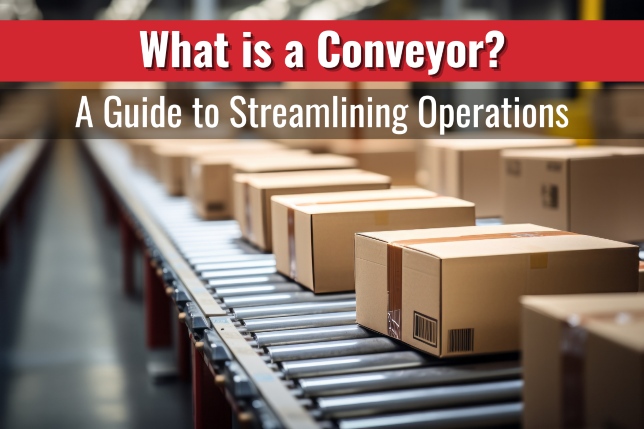Have you ever wondered how grocery stores are restocked so smoothly or how your luggage effortlessly makes its way from check-in to the airplane? These daily wonders are enabled by an unsung hero: the conveyor. But what is a conveyor?
This article delves into what is a conveyor system, not just as a means of transporting items but as a marvel of mechanical engineering. These systems enhance efficiency and reduce manual labor across various sectors, from supermarket checkouts to mining operations, making them an essential part of modern industry.
We will cover topics such as:
- What is a conveyor system
- Components of a conveyor system
- Types of Conveyor Systems
- Benefits and Uses of Conveyor Systems
- Applications of Conveyor Systems
- Common Questions and more…
Understanding Conveyor Systems
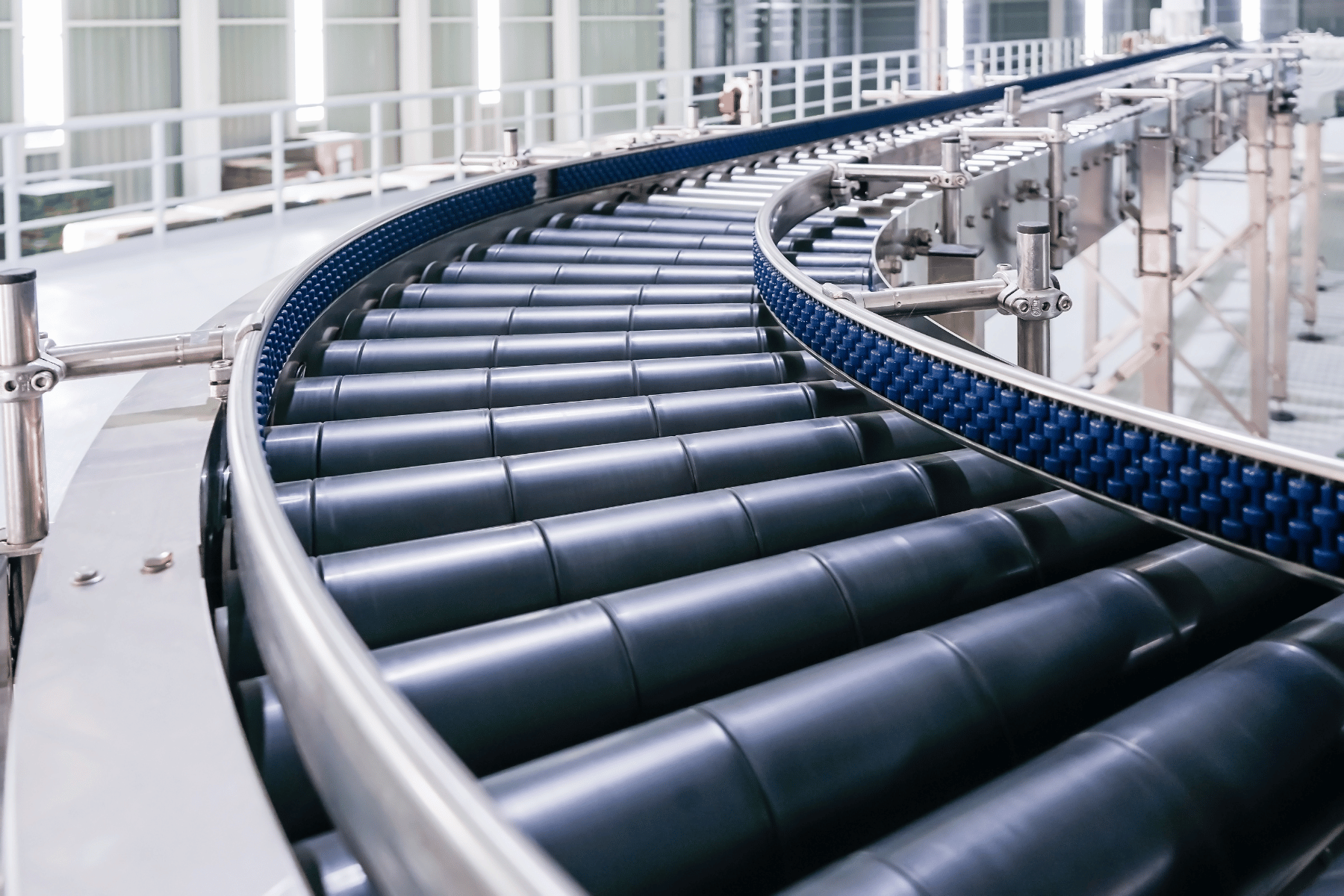
Do you know how your online purchase quickly lands on your doorstep or why grocery stores are incredibly efficient? The unsung hero behind this seamless operation is the conveyor system, a key player in ensuring speed and efficiency from behind the scenes.
What is a conveyor system?
A conveyor system, in its essence, is mechanical handling equipment that moves materials from point A to B. But it is not just about movement, but about making life easier.
These systems are pivotal in various industries for transporting heavy or bulky materials. Imagine manually moving thousands of packages daily – sounds exhausting, right? That is where conveyors come into play.
Inner workings of a conveyor system
You might assume these systems operate on complex magic. However, it is a blend of simple yet brilliant engineering at work.
The heart of a conveyor lies in its ability to use rollers, wheels, or belts – supported by frames – that guide materials along their merry way.
Whether powered by motors or the conveyor’s gravity, they ensure everything from small parcels to large raw materials reaches their destination effortlessly.
Components of Conveyor Systems
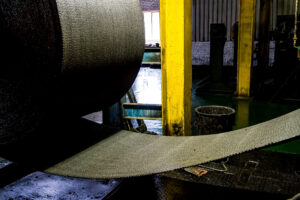
In material handling, conveyor systems are crucial for efficiently transporting items from one location to another.
These systems are vital across various industries, including manufacturing, distribution, and food processing.
It is crucial to grasp the elements of a conveyor system to enhance your operation. Let us delve into these essential components vital for any effective conveyor configuration.
Belt
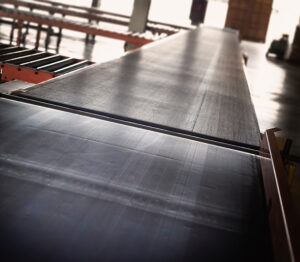
The conveyor belt is the core of any conveyor system, acting as the platform for material transport.
Depending on their application — from transporting bulky machinery components to fragile food products — belts come in diverse materials and designs.
Choosing the right conveyor belt is crucial for operational efficiency and durability, ensuring that it meets the specific needs of its intended use.
Rollers
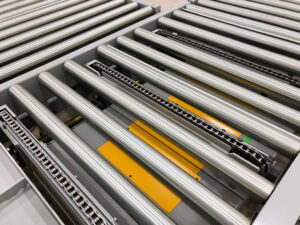
Conveyors utilize rollers to support and move belts carrying loads.
These cylindrical parts are crafted from metal, plastic, or rubber based on their use, each providing unique benefits such as lower friction and decreased noise levels.
Pulley System
A pulley plays a critical role by applying force against belts or chains, which cause them to move along their tracks; this includes both drive pulleys, which power movement, and idler pulleys that guide without transmitting power directly themselves but still influence overall functionality significantly.
Chain
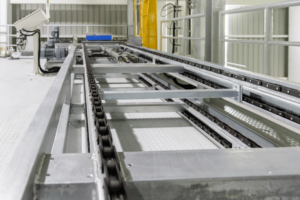
In chain-driven conveyors, chains link sections together to provide movement through sprockets—a method commonly used for heavier loads where direct belt drive is not feasible due to slippage risks or when precise positioning is required.
Idlers
Idlers, positioned at regular intervals along the frame lengths act as belt support and reduce resistance during movement.
Available in various designs, with flat rollers being the most common, they are tailored to meet specific needs like optimizing load distribution over larger spans.
The Frame Structure
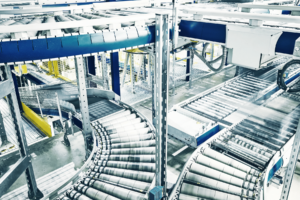
This component acts like the backbone, providing essential structural support to maintain proper alignment under different stress conditions.
It is like scaffolding that organizes all other elements, ensuring stability and durability for everyday use without compromising the structure.
Each element listed above contributes uniquely towards making sure your facility’s conveyor system runs smoothly; neglecting even one aspect could lead to disruptions down the line affecting productivity adversely so keeping abreast of developments related technologies will always serve well long term!
Key Takeaway:
Each element listed above contributes uniquely to ensuring your conveyor system runs smoothly. Overlooking any single element can lead to significant disruptions, negatively impacting productivity. Therefore, staying updated with technological advancements is crucial for long-term success and smooth operations.
What is a Conveyor Systems Benefits

The demand for effective and dependable material handling solutions is paramount in the fast-moving industrial landscape.
Conveyor systems are critical in enhancing operations across multiple sectors, including manufacturing, distribution, food processing, paper production, packaging, and lumber.
Time Savings
The essence of productivity in any business operation lies in its ability to save time without compromising on quality or output.
Conveyor systems excel in this area by facilitating the rapid movement of materials across different stages of production or storage processes.
This seamless process removes manual handling delays, streamlining operations and enhancing efficiency effectively.
Continuous Operation

Conveyor systems typically operate continuously, unlike human workers who need breaks and shifts.
This functionality eliminates production or distribution delays for timely market supply.
Their relentless running capacity ensures efficiency in meeting demands without any bottlenecks in the workflow.
Automated Unloading
Integrating automation within conveyor systems has revolutionized how businesses handle unloading tasks.
Automated unloading features reduce the need for manual intervention, thus minimizing errors and enhancing safety standards during material discharge phases.
Control of Movement

Precision is paramount when moving heavy items within a facility; too much speed or rough handling can damage products, leading to losses.
Conveyors provide controlled movement, ensuring that items reach their destination safely while maintaining desired speeds throughout transit paths.
Low Maintenance
Conveyor systems are engineered for durability, enabling them to withstand prolonged usage while necessitating minimal maintenance.
This design approach significantly lowers the total operating costs over time by minimizing the need for frequent and costly upkeep.
Safety Enhancements & High Volume Handling Capabilities:
-
- Safety: Conveyors enhance workplace safety by reducing direct worker interaction with heavy materials, thereby lowering the risks linked to manual lifting.
- High Volume: Conveyors excel in handling high volumes, from bulk materials and small parts to large pallets. They maintain efficiency under heavy workloads, making them essential for mass production or distribution environments that demand rapid throughput.
Key Takeaway:
Conveyor systems work to enhance efficiency and safety by enabling seamless workflows and automated unloading. Their main purpose is to provide exact control over movement to prevent damage, require low maintenance, improve safety by minimizing human error, and efficiently handle high volumes of materials.
Cost of Conveyor Systems

When planning conveyor systems, it’s important to consider the full cost, which varies by system type, space, and productivity needs.
Conveyors improve handling and speed up tasks, but their cost includes more than just the equipment itself.
Here’s a breakdown:
- Upfront Costs: Basic conveyors range widely, with advanced models costing $2,000 to $5,000 per linear foot. Features like speed adjustments, curves, or custom loading can increase cost.
- Installation Costs: Installation includes labor and possible warehouse adjustments, especially for complex systems like overhead conveyors, which require specialized setup and structural changes.
- Maintenance and Operating Costs: Routine maintenance costs play a significant role in the total cost of ownership (TCO) for conveyor systems. Regular checks are essential to avoid breakdowns and keep the system safe and efficient, especially for heavy-duty conveyors.
- Productivity Gains: Despite the initial expense, conveyors reduce manual work, improve accuracy, and speed up processes, which can save money over time.
By balancing these costs with your productivity and safety goals, you can create an efficient and sustainable system that supports business growth.
Maintaining Conveyor Systems

To keep conveyor systems working well and lasting longer, regular maintenance is key.
Good practices help conveyors, whether they’re belt, roller, or overhead, run smoothly and reduce unexpected stops. Here’s what it takes to maintain a reliable conveyor system:
- Routine Inspections and Audits Regular checks help catch wear on key parts like belts and motors. Scheduled system audits can catch issues early, helping the conveyor run smoothly for a long time.
- Motor and Reducer Checks Motors and reducers power the conveyor, so they need close attention. Signs like overheating or strange noises can point to issues. Regular service and replacing worn parts can help avoid major repairs and keep material moving.
- Keeping Spare Parts Having spare parts like rollers and belts on hand allows for quick repairs and prevents long downtime. This keeps the conveyor running without delays.
- Training Staff Proper training for operators helps prevent misuse and damage. Well-trained staff can handle complex systems like overhead conveyors safely and effectively.
- Choosing the Right Conveyor Type Picking the right conveyor for the job—like belt conveyors for gentle handling or chain-driven rollers for heavy loads—can make a big difference in lifespan. Overhead conveyors work well in tight spaces but need extra care.
Following these tips helps companies get the most out of their conveyors. Working with a supportive manufacturer also makes maintenance easier, boosting productivity and reliability for years to come.
Types of Conveyor Systems
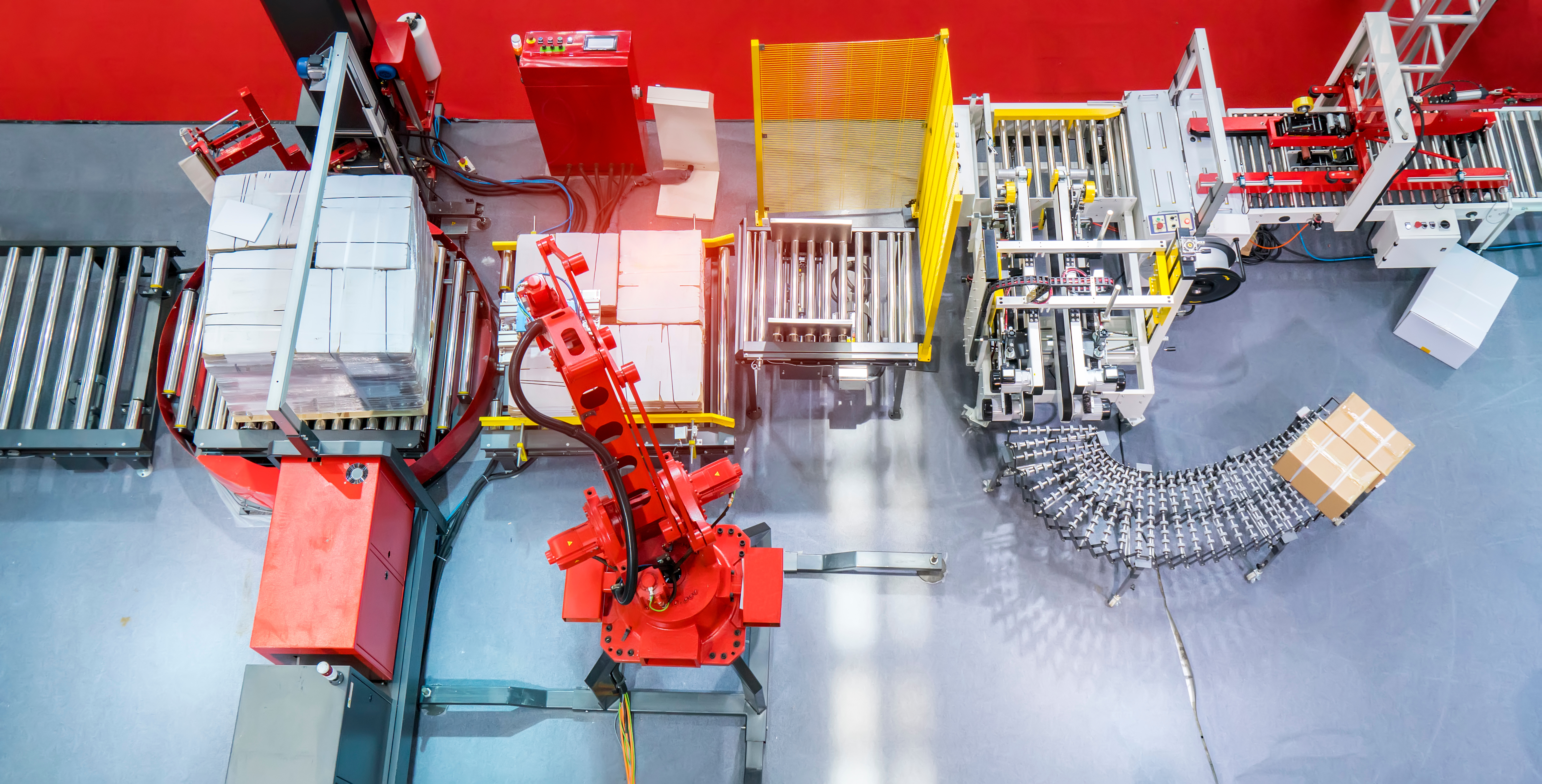
Exploring the realm of conveyor systems reveals a space where automation and efficiency flow seamlessly together. Each system is uniquely engineered, boasting specific strengths tailored for particular tasks, showcasing innovation in motion.
Gravity Conveyors
The simplest form among all conveyor types is the gravity conveyor.
Utilizing gravity makes it the to move products manually or via natural decline, gravity rollers are cost-effective for light to medium-weight items. The Ideal conveyor for quick, easy, and energy-efficient transportation within facilities.
Powered Conveyors
A powered conveyor utilizes motors to move materials along flat or inclined paths, offering versatility for heavy-duty industrial use.
Powered rollers can accommodate various product weights and sizes, making them ideal for many applications.
Belt Conveyor

A staple in many industries, belt conveyors feature continuous belt movement that can carry goods over long distances at variable speeds. Perfect for transporting both bulk materials and unit loads like boxes or pallets.
Roller Conveyors
Comprising a series of rollers driven by electric motors or gravity, roller conveyors are highly efficient in swiftly moving bulk goods.
They’re particularly beneficial in packaging lines where speed is of the essence.
Overhead Conveyors

Overhead conveyors stand out as a beacon of efficiency.
These innovative systems are designed to transport objects across facilities while maximizing floor space – an essential factor for businesses aiming to optimize conveyor operations without expanding their physical footprint.
Pneumatic & Screw Conveyors: For Specialized Applications
- Pneumatic Conveying Systems: pneumatic conveyors utilize air pressure or vacuum forces to transport objects through tubes – ideal for fine powders or granular substances commonly found in food processing plants.
- Screw (Auger) Conveyers: Best suited for moving semi-solid materials like sludge or wood chips thanks to their helical screw blade mechanism.
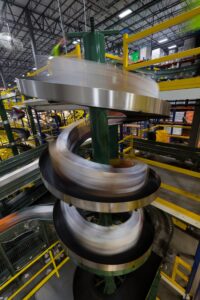
Vibrating & Spiral Options: Unique Material Handling Solutions
-
- Vibrating Conveyor Systems: Leverage mechanical vibrations to provide smooth conveying. They are beneficial when dealing with delicate items that require gentle handling.
- Spiral Conveyor System: Ideal for saving precious floor space, these solutions enable vertical movement to multiple levels without sacrificing product quality when elevation shifts are necessary.
Key Takeaway:
Conveying systems consist of a variety of forms to suit different industry needs. Affordable gravity conveyors handle light objects, while robust belt conveyors move bulk materials efficiently. Specialized designs like pneumatic and screw conveyors offer unique solutions, with vibrating and spiral conveyors adding versatility. This range ensures an efficient handling solution for every requirement across sectors.
Applications of Conveyor Systems

Conveying systems work as the lifelines of various industries, facilitating the transport and handling of materials within manufacturing processes, warehousing operations, and more.
Their versatility makes them indispensable.
Manufacturing: Enhancing Production Lines
In manufacturing, conveyor systems play a pivotal role in streamlining production lines. They efficiently move parts between different stages of production without manual intervention, significantly reducing labor costs and enhancing productivity.
Metalworking plants benefit immensely from specialized conveyors that can handle heavy materials and resist abrasion, ensuring smooth operation even under harsh conditions.
Warehousing and Distribution: Optimizing Packaging and Logistics

The dynamic environment of warehousing and distribution centers relies on conveyor systems for sorting, packaging, and dispatching goods with precision.
Warehouse managers who use these systems typically reduce order processing times by automating movements between storage areas to packing stations or loading docks.
By integrating advanced technologies like barcode scanners into conveyor belts, businesses can further enhance tracking accuracy throughout their logistics chain.
Transportation: Supporting Critical Infrastructure
Airports around the globe utilize extensive conveyor designs for baggage handling. Swiftly transporting luggage from check-in counters to aircraft or reclaim areas.
Similarly, mining operations depend on robust belt conveyors for transporting extracted materials over long distances across rough terrains.
The automotive industry’s conveyor systems conveyor parts for assembling vehicles efficiently at every stage along the production line.
Food Industry: Ensuring Hygiene in Processing & Packaging

The food industry benefits greatly from using specially designed sanitary conveyors that adhere to strict hygiene standards required during the processing and packaging phases.
These conveyors work to minimize human contact with food items, reducing contamination risks while speeding up overall production flow – crucial factors when dealing with perishable products.
Common Conveyor Questions
What is a conveyor used for?
A conveyor system is an essential component in the realm of material handling, designed to efficiently move goods, products, raw materials, and other items from one location to another within a facility.
Its application spans various industries including manufacturing, distribution centers, food processing and storage, as well as paper, packaging, and lumber sectors.
Conveyors are pivotal in streamlining operations by facilitating the rapid transport of bulk materials or individual units while reducing manual labor requirements and enhancing safety and productivity.
What are the three common types of conveyors?
The primary categories of conveyors utilized in material handling and industry operations include belt conveyors, roller conveyors, and chain conveyors.
Belt conveyors consist of a continuous looped belt that transports materials or products from one point to another.
Roller conveyors leverage a series of rollers to move goods either by gravity or manual power.
Chain conveyors use a chain mechanism to pull pallets or large items along their path. Each type offers distinct advantages depending on the application’s specific requirements.
What is a conveyor in engineering?
In engineering, a conveyor refers to a mechanical apparatus designed to transport materials or objects from one location to another within a defined pathway.
This system employs various mechanisms such as belts, chains, rollers, or buckets to facilitate the movement of items across distances short or long.
Conveyors are integral components in numerous industries for their efficiency in material handling, streamlining production processes, and boosting efficiency.
What is a conveyor in a factory?
A conveyor in a factory is an automated or semi-automated system designed to transport materials, products, or parts from one location to another within the manufacturing or distribution process.
It serves as an efficient means of moving goods through production lines, improving workflow and productivity.
Conveyors can vary widely in type, including belt, roller, overhead systems, and more, tailored to specific industry needs and material handling requirements.
What is a conveyor in Agriculture?
Agricultural conveyors, designed to transport bulk materials in farming settings, utilize a frame that supports rollers, belts, chains, or slats.
The choice of component depends on the material being moved; for example, belt conveyors are used for delicate produce to avoid damage.
These systems vary from portable units for grains or feed to large fixed setups for moving crops over great distances.
Conclusion

So, there you have it. The world of conveyors is far more than just belts and rollers.
They are the backbone of the industry. A silent partner in efficiency working behind the scenes to ensure your groceries land on shelves and your luggage makes its way onto planes.
This mechanical marvel does not ask for applause or recognition but deserves a moment in the spotlight for all it does to keep the wheels of commerce spinning smoothly.
From mining operations hefting tons of materials to airports managing thousands of bags daily, conveyors are everywhere—making life easier and businesses more efficient one move at a time.
